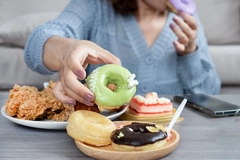US holiday food shopping tops last year’s bill despite financial hardships
12 Dec 2022 --- Despite the ongoing threat of a looming recession and financial hardships including rising food prices, it appears that food buyer trends and preferences remain merry and bright – not having drastically changed in the context of holiday shopping.
In fact, data from the Food Industry Association (FIA) reveals that US shoppers are spending even more money at stores compared to 2021 – indicating market hope for the F&B economy as the end-of-year festivities draw 2022 to a close.
This year, typical holiday stress is exacerbated by inflationary concerns, with 62% of shoppers reporting their grocery costs have increased year-over-year. Despite inflation-induced concerns, average weekly household grocery spending is currently at US$148 per week, which is down from the US$161 peak during the height of the COVID-19 pandemic.

“Food is the centerpiece for so many of our holiday gatherings. Despite inflationary pressures, consumers are determined to enjoy the festivities this year as they normally do,” comments Leslie Sarasin, president and CEO of FMI.
“The food industry is working tirelessly to keep costs down and to ensure that our timeless traditions can continue during this holiday season.”
FIA highlights that shoppers remain resilient and if they run into stock issues when holiday food shopping, with 50% disclosing they would try something new, while 36% would look for a new recipe.
 Hershey’s Hot Chocolate Bomb (Credit: The Hershey Company).Food brands mitigate prices
Hershey’s Hot Chocolate Bomb (Credit: The Hershey Company).Food brands mitigate prices
Shortages were a hallmark of the pandemic across many industries, but progress made by food retailers and suppliers to curb widespread supply chain issues has kept consumer confidence up heading into the holidays, reports FIA.
Only 27% of consumers report being “very concerned” about food items needed for holiday meals being out of stock. This quarter saw a poultry shortage linked to the escalating spread of bird flu. Particularly in the UK, over half of the UK’s free range turkeys have been recently culled or died, leaving the industry at a loss approaching Christmas.
Heading into the holiday season, 45% of consumers report being most concerned about rising meal prices as compared to other holiday expenses. Fortunately, most shoppers indicate they are in control of their grocery budgets, with 71% of consumers making some adjustment to their holiday meal shopping to adapt to the changing economic landscape. This indicates that shoppers are still able to find budget-friendly items to meet their needs.
To mitigate increased costs, consumers say they are looking for deals (28%), choosing store brands (21%), enjoying more home-cooked meals (20%), making fewer dishes overall (17%), substituting more affordable options (17%), encouraging guests to bring dishes (17%) and spending less in other categories to provide holiday meals (17%).
Chocolate bombs away
Hot chocolate bombs are a trend that tends to resurface during the cold winter months, popularized in 2019 when TikTok user Eric Torres-Garcia was inspired to create the convenient beverage format. The powder and sprinkle mix used in the drink are encased in a sphere of chocolate that melts away when coming into contact with hot milk or water.
Torres-Garcia took inspiration for the treat from the concept of a Kinder egg – a chocolate egg that contains a toy inside – as well as the popular trend of bath bombs.
This year, The Hershey Company released its own version of hot chocolate bombs, available with marshmallows or cinnamon chips inside.
The brand also “dressed up” its Milk Chocolate Holiday Bars for the holidays, with 24 varieties of seasonal imprinted images such as stars, wreaths, trees, stockings and more. It has also released Grinch-themed Hershey’s Kisses products inspired by author Dr. Seuss, while returning its Reese’s Peanut Butter Trees.
In the spirit of inclusivity, Purdys Chocolatier has launched a chocolate gift set with braille inscribed on the box (Credit: Purdys Chocolatier).Baileys brought back its take on the hot chocolate bomb, infusing it with its signature Irish creme liquor and adding marshmallows to the mix. In addition, the brand introduced a Chocolate Collection exclusive to Sainsbury’s, including white and dark chocolates oozing with Baileys.
Fireside snacking
According to Innova Market Insights data released this month, one in four respondents globally say that seasonal or limited edition flavors influence their food and beverage choices. The market researcher highlights that Christmas NPD, in particular, saw a 14% CAGR this year.
Europe led as the top region accounting for the highest percentage of Christmas-themed F&B launches at 65%, followed by North America (13%), Latin America (11%) and Asia (6%).
In festive launches, F&B treats are taking on themed formats – such as Iceland’s Luxury Sausage Roll Wreath – as well as offering unique hybrid taste profiles, like Jelly Belly’s chocolate-flavored sparkling water.
With nostalgia storytelling being a particularly attractive purchasing driver, some brands are focusing on illustrating cultural icons, such as chocolate brand Zotter Labooko’ Krampus and Santa Claus Chocolate, whose packaging displays images of both Germany’s advent season demon figure Krampus and Saint Nick – made “with milk from the Tyrolean mountain farmers.”
In the spirit of inclusivity, Purdys Chocolatier has launched a chocolate gift set with braille inscribed on the box. “This 18-piece gift box features Braille orientation tabs and a Braille chocolate legend, as joy should be accessible to as many people as possible,” reads the packaging.
Among other launches, classic brands are introducing wintery flavors for their staples, as is customary. In the savory aisle, Planters released its own take on holiday nut flavors, such as Holiday Nut Crunch – featuring roasted nuts, including almonds, cashews and peanuts – alongside a Winter Spiced Mix, containing honey roasted peanuts, almonds, honey roasted sesame sticks, cashews and pecans with a hint of sea salt.
Craftzero has introduced advent calendars of alcohol-free beverage varieties (Credit: Craftzero).Edible advent calendar
As taste discovery retains its appeal for adventurous consumers, advent calendar-style products offer a way to showcase a broad product sampling range for new customers.
BeanCurious has launched its first Christmas gift box in this style. The 6 Beans of Christmas contains five “highly rated” coffees sourced from Rwanda, Ethiopia, Honduras, Guji, El Salvador and one “rare micro-lot coffee” from Nicaragua, only offered in this set.
The coffee in this set is freshly roasted in Hong Kong and shipped out as whole-bean coffee. Each pack contains 60g of arabica beans, enough for three espresso shots or cups of pour-over coffee.
For adults, Gintonica released a 12 days of Australian Craft Gin advent calendar, which hides 12 miniature 50 ml craft gin bottles behind each of its doors. In the wine category, The Australian Wine launched a 24 day-format of wine discoveries from across the globe. This includes French, Italian and Portuguese reds, whites and roses – as well as a prosecco to toast Christmas Eve.
The Masters of Malt has also released a “carefully curated calendar” of 24 doors revealing 30ml hand-waxed bottles of whisky, including a 10-year-old Laphroaig with a sherry oak finish, a Balvenie DoubleWood 12-year-old and a Brenne French single malt.
For the sober crowd, Craftzero introduced two new varieties of its non-alcoholic advent calendar – one for beer lovers and another packed with a non-alcoholic assortment of spritzes and seltzers.
T2 released three tea-themed advent calendars of tea bag or loose-leaf varieties alongside a deluxe version complete with a bone china mug, infusers, candles, spoons and a selection of teas.
In budget confectionery offerings, Trolli released a Fruity Gummi Advent Calendar of chewy sweets, while Lindt introduced a Lindt Teddy Advent Calendar of bear-shaped chocolates. Cadbury has also rolled out a 3D Advent Calendar – a giant tower full of all the brand’s classic chocolate bars Crunchie, Boost, Freddo and Dream, among others.
By Benjamin Ferrer












